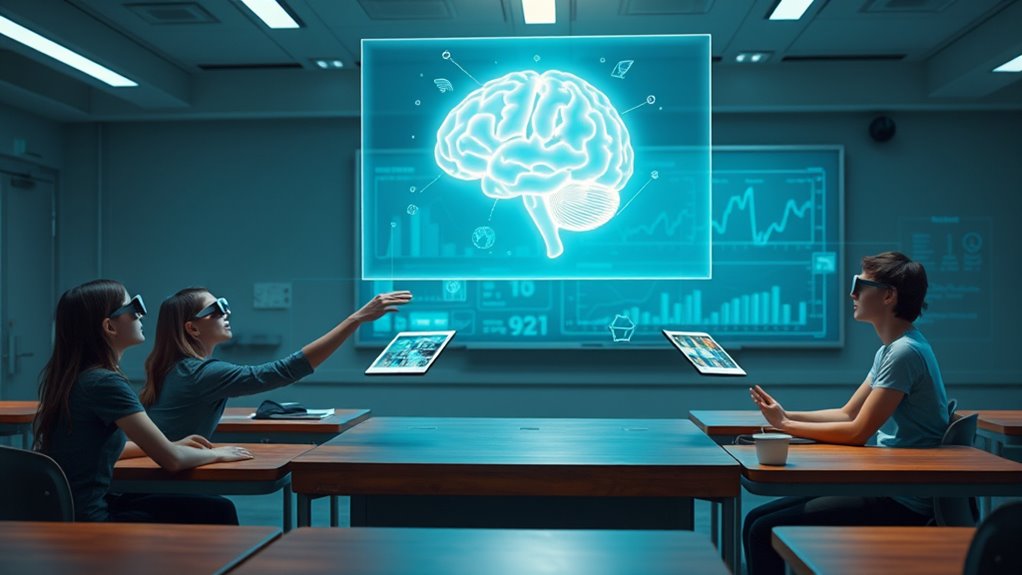As you explore the future of AI classrooms, consider the impact of digital detours like distractions and disparities. Digital devices can boost engagement but often lead to students drifting off-task, affecting learning outcomes. Meanwhile, the digital divide limits access for marginalized students, challenging equity. Overcoming these hurdles requires innovative solutions and inclusive infrastructure. Keep going to discover how these challenges shape the path toward more effective and equitable AI-powered education.
Key Takeaways
- Digital distraction challenges in classrooms highlight the need for AI tools that enhance focus and engagement.
- The digital divide limits equitable access to AI-driven educational resources for marginalized students.
- AI can personalize learning experiences, but unequal access risks widening existing educational gaps.
- Addressing digital infrastructure disparities is essential for effective integration of AI in diverse educational settings.
- Solutions like digital navigation services can help bridge access gaps, ensuring AI benefits reach all learners.

Have you ever wondered how technology’s rapid integration into education is both helping and hindering learning? On one hand, digital tools can make lessons more interactive and accessible, but on the other, they introduce new challenges that disrupt student focus and deepen inequalities. Digital distraction is a growing concern; students often check social media, send messages, or browse unrelated websites during lessons, breaking their concentration. Studies show that 75% of students use their phones in class, with distraction happening multiple times per session. Factors like age, gender, and internet addiction influence how often students get sidetracked, but teachers consistently notice that digital distraction hampers engagement and overall learning outcomes.
Digital distraction in classrooms disrupts focus and hampers student engagement across all age groups.
Meanwhile, the digital divide creates another obstacle. During COVID-19, over 826 million learners lacked household computers, and 43% had no internet access at home. This gap is especially stark in low-income regions like sub-Saharan Africa, where nearly 90% of students lack computers and internet. Some students live in areas without mobile networks at all, making remote learning nearly impossible. These disparities restrict educational continuity, widen learning gaps, and threaten the promise of equitable education. UNESCO emphasizes the importance of alternative methods, like radio and TV broadcasts, to reach students who can’t access online platforms.
The pandemic exposed how digital inequities disproportionately affect marginalized students. Many faced complete school closures or relied solely on paper-based materials because their households couldn’t provide reliable internet or devices. These students not only missed instructional time but also struggled to develop the digital skills necessary to participate in remote learning. Teachers found it harder to connect with these students, which affected relationships and motivation. The digital divide isn’t just about access; it impacts digital literacy and the quality of engagement, ultimately influencing academic achievement. Additionally, the lack of access to devices and reliable internet can hinder students from experiencing high-quality educational content, further widening the achievement gap.
In the U.S., over 12 million students lack adequate digital access, especially those from lower-income families. One in seven students in households earning below $75,000 struggles with broadband connectivity. These gaps hinder participation in virtual classes, completing assignments, and collaborating online. Emerging digital navigation services aim to bridge this divide, but the challenge remains: as classrooms move further into digital domains, achieving true digital equity becomes essential for meaningful learning.
Frequently Asked Questions
How Will AI Address Diverse Learning Styles?
AI addresses diverse learning styles by tailoring content to your preferences, whether visual, auditory, kinesthetic, or reading/writing. It adapts in real-time based on your input, adjusting difficulty, pace, and format to keep you engaged and improve understanding. AI also offers accessible tools for all students, including those with disabilities, ensuring equitable learning. With ongoing data analysis, it provides personalized feedback and support to meet your unique educational needs.
What Measures Ensure Student Data Privacy?
Did you know that 87% of schools now use EdTech tools with varying privacy standards? To protect student data, you should guarantee compliance with laws like FERPA and COPPA, and use data minimization practices. Implement strong security measures such as encryption and role-based access. Keep stakeholders informed through transparent policies, and regularly audit security systems. Training staff on privacy protocols and involving parents helps create a culture of trust and accountability.
How Do Digital Detours Impact Teacher Training?
Digital detours disrupt teacher training by causing inconsistent, fragmented learning experiences. You might find yourself stuck in one-off workshops or incomplete programs that don’t build lasting skills. These detours hinder your confidence with digital tools and leave gaps in your understanding. To stay on course, you need sustained, personalized professional development that adapts to your needs, helping you confidently integrate technology and improve student outcomes.
What Role Will Traditional Classrooms Play?
Imagine a classroom where students bond over group projects, building social skills face-to-face. Traditional classrooms will stay crucial by fostering emotional intelligence, teamwork, and mentorship that AI can’t fully replace. You’ll use them as hubs for blended learning, combining hands-on activities with AI tools for personalized practice. Teachers will continue guiding, supporting, and interpreting data, ensuring students develop holistically in environments where human connection remains essential.
How Can AI Foster Critical Thinking Skills?
You can foster critical thinking skills with AI by encouraging curiosity and inquiry, prompting you to verify information and question AI outputs. Use AI tools as scaffolding for complex problems, helping you explore multiple perspectives. Remember, AI should support your reasoning, not replace it. By analyzing biases and evaluating reliability, you develop deeper understanding and independent judgment, making AI a powerful partner in honing your critical thinking abilities.
Conclusion
As you navigate the digital detours in education, remember that technology offers both pitfalls and promise. While AI can personalize learning and bridge gaps, it also risks widening inequalities and losing human connection. The road ahead isn’t just about cutting-edge tools; it’s about balancing innovation with empathy. Embrace the journey, learn from setbacks, and steer toward a future where technology enhances, rather than replaces, the heart of teaching.










